Sino-Israeli drone cooperation
Unmanned aerial vehicles ASN-104, ASN-105 and ASN-205
As already mentioned in the first part of the review, the Chinese military at the beginning of the 1980's had some experience in operating UAVs. The troops operated light, very primitive models with radio control, a glider made of plywood and low-power piston engines. The main purpose of these drones was to train anti-aircraft artillery calculations. Technologically more advanced reactive unmanned targets and reconnaissance, created on the basis of American and Soviet models. The developments in the PRC and cooperation with Western companies made it possible to very quickly create and adopt small drones that could be used for reconnaissance in the front-line zone, adjusting artillery fire and jamming enemy radar.
In 1985, the pilot operation of the D-4 UAV, which later received the designation ASN-104, began. This remotely piloted vehicle was developed by specialists from the UAV laboratory at the Xi'an Research Institute (later reorganized into the Xian Aisheng Technology Group) and is made primarily of fiberglass reinforced with carbon fiber.
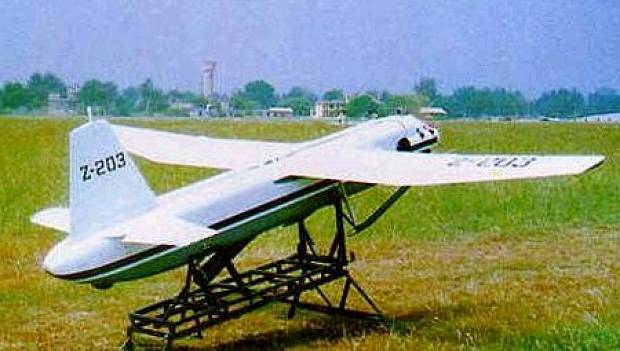
ASN-104 is built in the same way as the first Chinese radio-controlled targets Ba-2 and Ba-7. It looks like a miniature piston aircraft and is equipped with a four-cylinder HS-510 four-cylinder air-cooled piston engine (maximum power 30 hp) installed in the front of the unit. Wingspan - 4,3 m. Length - 3,32 m.
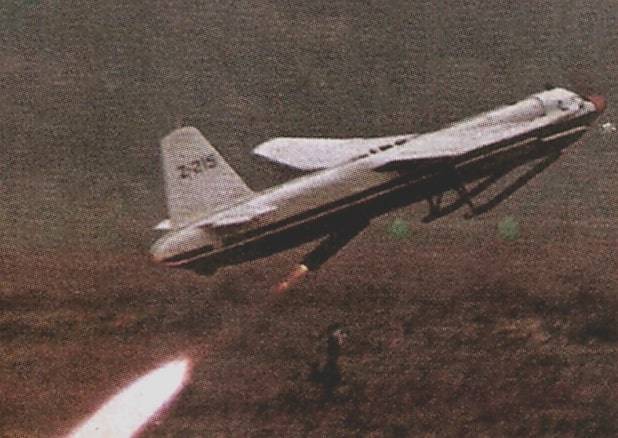
Initially, the apparatus was launched from a towed launcher using a solid fuel accelerator. Later, the launcher was placed in the back of a Dongfeng EQ 1240 army truck. Landing was carried out using a parachute.
For its time, ASN-104 had some pretty good specs. An apparatus with a take-off mass of 140 kg could conduct reconnaissance at a distance of up to 60 km from the ground station. 18 l fuel tank was enough for 2 hours of flight. Maximum speed - up to 250 km / h. Cruising - 150 km / h. Ceiling - 3200 m. The payload weighing up to 10 kg included photos and cameras.
A drone equipped with an autopilot, a remote control system, a telemetry system and television signal transmission equipment could fly under the control of a ground station or according to a predetermined program. The UAV unit consisted of six drones, three launch devices, a command and control machine with equipment for remote control and reception of intelligence information in real time, as well as a laboratory for processing photo materials.
According to Western data, the first ASN-104 squadrons reached combat readiness in the 1989 year. After training at the Dingxin training ground in Gansu, units equipped with drones were sent to Heilongjiang and Yunnan, in the border areas with the USSR and Vietnam.
Having comprehended the experience of operating the ASN-104 UAV, the Chinese military leadership set the designers the task of increasing the range of reconnaissance and introducing a night channel into the reconnaissance equipment. In accordance with these requirements, at the beginning of the 1990's, the UAV received the designation ASN-105 entered service. This unit looks like ASN-104, but it has become the largest.
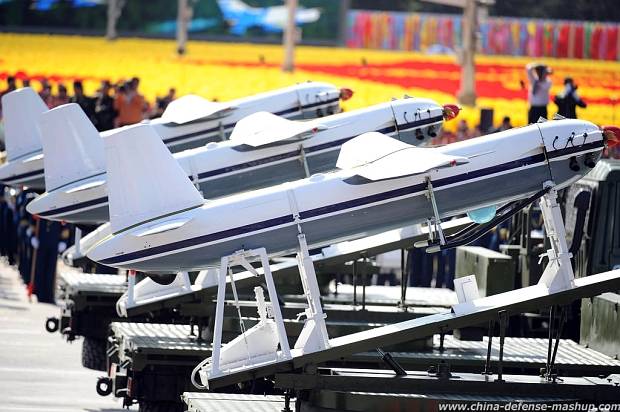
According to information published by Chinese media, the ASN-105 UAV weighs 170 kg in prepared condition for departure. Wing span - 5 m, length - 3,75 m. Maximum speed compared to ASN-104 became less and amounted to 200 km / h. However, this indicator is not as important for an unmanned reconnaissance vehicle as the duration of the flight, which increased to 6 hours. On a modification known as ASN-105А, the maximum flight altitude increased to 5000 m, which reduced vulnerability from MZA and short-range mobile air defense systems.
Thanks to the use of new control equipment, a telescopic antenna mast device with a height of 18 m and an increase in the power of the television transmitter, it became possible to control the drone and receive a television picture from it at a distance of up to 100 km. In the case of a departure in the dark, night-vision cameras are used.
In the 2009 year, at the military parade dedicated to the 60 anniversary of the founding of the PRC, an improved version was demonstrated, which was designated ASN-105В. The Dongfeng EQ1240 three-axle off-road truck was used as a launch vehicle.
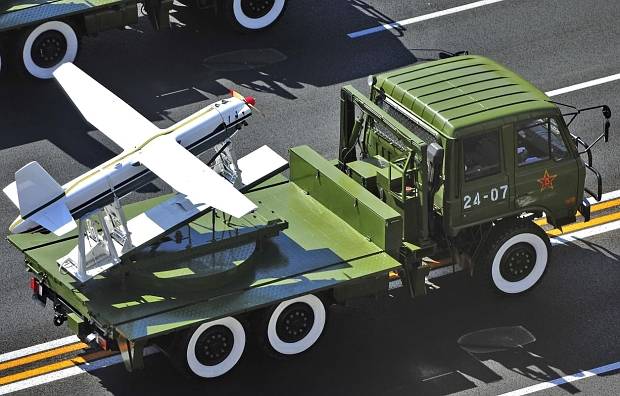
Although the glider and propulsion system of the drone did not undergo any special changes, its electronic filling was significantly improved. It is reported that the ground control equipment is fully computerized, and the UAV electronic units have been transferred to a new element base. Thanks to the use of the Beidou satellite navigation system, the accuracy of determining the coordinates of the observed objects has increased, which in turn has increased efficiency in adjusting artillery fire and issuing target designation for its aircraft. In addition, if the drone is used in program mode or when the control channel is lost, it is highly likely to be able to return to the launch point. All reconnaissance information obtained during the flight was recorded on electronic media.
A further development option for the ASN-105 UAV was ASN-215. At the same time, the weight of the aircraft increased to 220 kg, but the dimensions remained the same as those of the ASN-105.
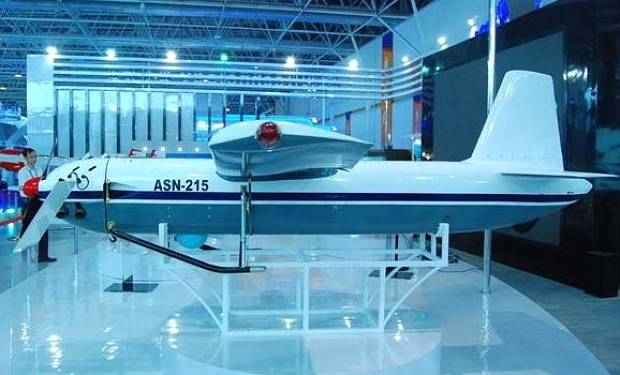
Due to the increase in payload mass, it was necessary to install a high-power engine and reduce the fuel supply on board. For this reason, the time spent in the air was reduced to 5 hours. The maximum flight altitude does not exceed 3300 m. The maximum speed is 200 km / h. Cruising - 120-140 km / h. The increase in transmitter power allowed to increase the range of controlled flight to 200 km. Information from the television camera is transmitted to the control center via a digital channel. Compared to the ASN-104 / 105, the quality of the transmitted real-time picture has improved significantly. On the ASN-205, the all-day camera is located on a stabilized turntable in the lower part of the fuselage. That allows you to monitor the target regardless of the course and position of the drone. In order to expand the range of combat use, a modular version of the placement of the payload was used. If necessary, instead of visual reconnaissance equipment, an interference transmitter or a VHF radio signal repeater can be installed.
Light-class UAVs ASN-104, ASN-105 and ASN-215 were produced in large series and are still in service. They are a good example of the evolutionary improvement in the characteristics of the UAV family, created on the basis of a single platform. These relatively inexpensive and simple devices were intended for use in divisional and regimental units, mainly for reconnaissance in the enemy’s near rear and for monitoring the battlefield. Thanks to the use of high-resolution cameras and satellite navigation, it became possible to accurately adjust artillery fire.
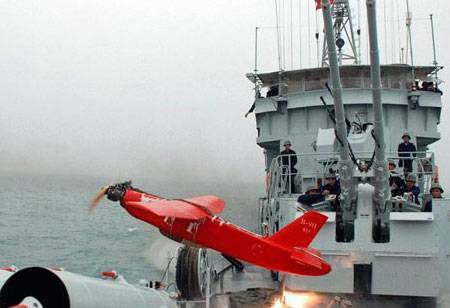
Subsequently, obsolete drones removed from service were actively used in the process of combat training of anti-aircraft calculations, both on land and at sea.
Sino-Israeli drone cooperation
It may seem strange, but at the end of the 20 century, China overtook our country in the creation of light and middle class unmanned aerial vehicles, and this superiority is still observed. This is largely due to the lack of understanding of the role of drones by the Soviet generals, and the general socio-economic recession that began in the Soviet Union in the middle of the 1980's. The Chinese high-ranking military, having concluded from the use of Israeli UAVs in Lebanon, considered them an inexpensive and quite effective means of armed struggle, which, if used correctly, could have a noticeable effect on the course of hostilities, even when confronted with a technologically advanced enemy. In the second half of the 1980, the leading developer and manufacturer of Chinese drones was the 365 Research Institute, located in Xi'an, in the central part of China.
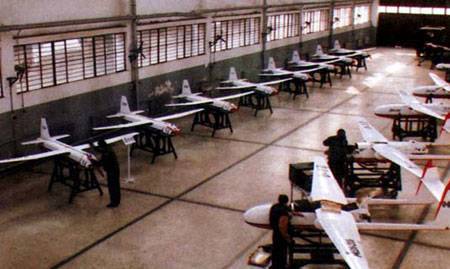
However, the achievements of Chinese designers, who created a line of successful UAVs, did not arise from scratch. Significant progress in this direction is associated with close Sino-Israeli cooperation, and the ability to copy control systems, video recording and data transmission installed on Israeli drones. As you know, Israel in the 1980-ies achieved significant success in the creation of UAVs, even the United States was in the role of catching up. Access to the PRC to Israeli technology was possible in the early 1980-ies, after the Chinese leadership began to make harsh anti-Soviet statements, provide substantial military and financial support to the Afghan mujahideen. In this regard, China began to be considered by Western countries as a possible ally in the event of a military conflict with the USSR. To modernize the Chinese army equipped with Soviet-style equipment and weapons developed in the 1950-1960 years, with the blessing of the United States, a number of European and Western companies began military-technical cooperation with the PRC. As a result of this, Chinese developers gained access to modern “dual-use products” at that time: avionics, turbojet engines, communications and telecontrol. In addition to purchasing individual components and assemblies, China has acquired licenses for the production of guided aircraft missiles, radars, airplanes and helicopters. The military-technical cooperation of the PRC with Western countries, which was interrupted in 1989 in connection with the events on Tiananmen Square, significantly increased the technological level of the Chinese defense industry, and made it possible to proceed with the modernization of the army with modern models.
Unmanned aerial vehicles ASN-206, ASN-207 and ASN-209
One of the most striking examples of Sino-Israeli cooperation was the ASN-206 UAV, which was jointly designed by the 365 Research Institute (a unit of Xi'an Northwest Polytechnic University engaged in unmanned aerial vehicles) and the Israeli company Tadiran, which assisted in the creation of airborne equipment and a ground control station. ASN-206 received a digital aircraft monitoring and control system, an integrated radio system and advanced flight control equipment. The development of ASN-206 lasted from 1987 to 1994 year. In 1996, the drone was presented at the international air show in Zhuhai, which came as a surprise to most foreign experts. Prior to this, it was believed that China was not able to independently create devices of this class.
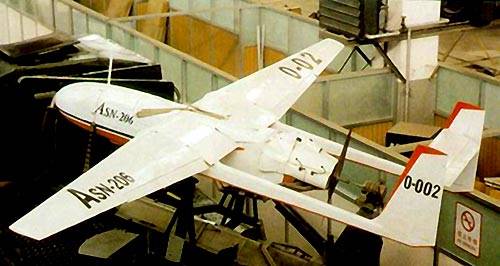
An ASN-206 UAV with a maximum take-off mass of 225 kg has a wing span of 6 m and a length of 3,8 m. The maximum flight speed is 210 km / h. The ceiling is 6000 m. The maximum distance from the ground control station is 150 km. Time spent in the air - up to 6 hours. Payload - 50 kg. According to the layout, the ASN-206 is a two-beam high wing with a thrust propeller that rotates the HS-700 piston engine with 51 horsepower. The advantage of this arrangement is that the rear arrangement of the two-bladed propeller does not obscure the line of sight of the overview optoelectronic devices installed in the lower front of the fuselage.
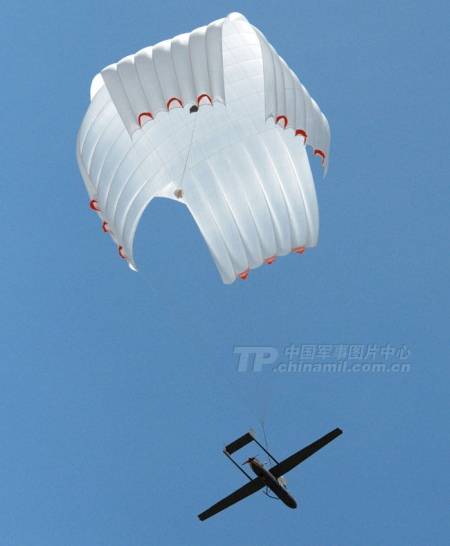
The launch is carried out from the launcher located on the cargo chassis, using a solid fuel accelerator. Landing with a parachute. The ASN-206 UAV squadron includes 6-10 drones, 1-2 launch vehicles, separate control, reception and processing machines, a mobile power supply, a gas tanker, a crane, technical assistance vehicles and vehicles for transporting UAVs and personnel.
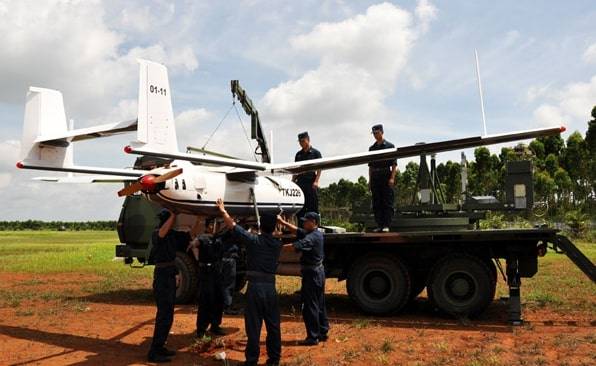
With the exception of the control station, the equipment of which is mounted in a minibus, all these other components are made on an off-road cargo chassis.
Depending on the purpose, various variants of the ASN-206 UAV can be equipped with a set of monochrome and color high-resolution cameras. On the drone there is a place for three day cameras, each of which can be replaced by an infrared camera. In later versions, an optoelectronic reconnaissance, surveillance and target designation system (with a laser target designator) is installed in a sphere with a diameter of 354 mm, having circular rotation and vertical viewing angles + 15 ° / -105 °. The received information can be transmitted to the ground station in real time. Alternatively, the drone can be equipped with a JN-1102 jamming station operating in the 20 frequency range up to 500 MHz. The JN-1102 equipment automatically scans the air and puts noise interference to enemy radio stations.
A further development option for the ASN-206 UAV was the enlarged ASN-207 (also known as WZ-6), which was put into service in the 1999 year. The machine with a take-off weight of 480 kg has a length of 4,5 m and a wingspan of 9 m. Maximum speed is 190 km / h. Ceiling - 6000 m. Payload mass - 100 kg. Flight duration - 16 hours. Range - 600 km.
The ASN-207 UAV, like the previous model, carries combined day / night optoelectronic equipment mounted on a rotating stabilized platform and a laser rangefinder-target designator. Since a high-frequency digital signal propagates within line of sight, a drone repeater known as the TKJ-226 is used to control the drone at maximum range.
This device is based on the ASN-207 UAV glider and is used with it in the same unmanned squadron. Externally, this modification differs from the reconnaissance version by the presence of vertical whip antennas.
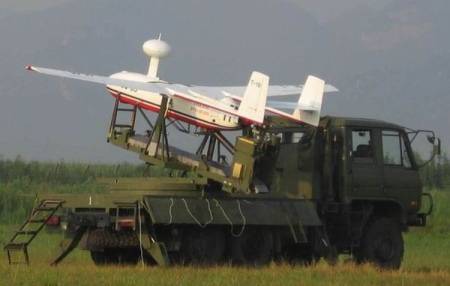
In the 21 century, images of the ASN-207 modification with a mushroom-shaped radar antenna, which is used in conjunction with an optoelectronic surveillance system, appeared in the Chinese media. A number of sources say that this model of the drone received the designation BZK-006. The characteristics and purpose of the radar are not known, but most likely it is intended for reconnaissance in poor visibility conditions. Since the frontal resistance increased during the installation of a massive radar fairing, the flight time of the BZK-006 UAV is 12 hours.
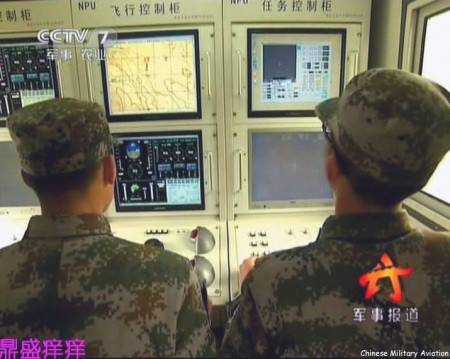
The flight of the BZK-006 is continuously monitored by two operators located in the mobile equipment room. One is responsible for the location of the drone in space, the other collects intelligence information.
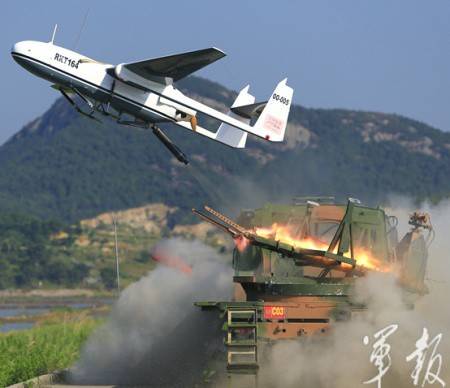
To suppress the enemy’s radio networks operating in the VHF range, the RCT164 UAV is designed. On this unmanned vehicle, in place of the mushroom-shaped fairing, a whip antenna is installed.
At an air show in Zhuhai held in 2010, the shock modification known as DCK-006 was demonstrated. Under the drone wing there are suspension units on which four miniature laser-guided missiles can be placed.
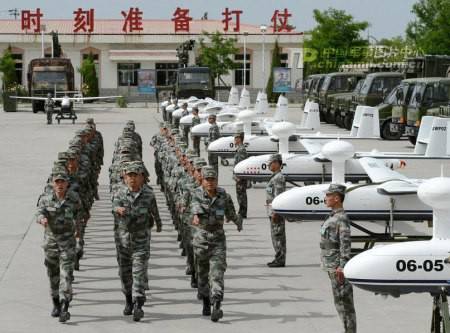
The PLA artillery reconnaissance units are currently massively equipped with the JWP01 and JWP02 UAVs, which are specifically designed to correct artillery fire.
The intermediate position in weight and size between the ASN-206 and ASN-207 UAVs is occupied by ASN-209 to monitor the battlefield on the ground, search for and track ground targets, control artillery fire and border patrols.
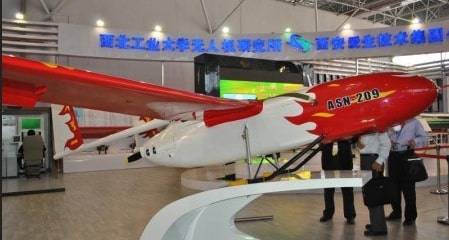
This model is 4,273 m long, with a wing span of 7,5 m, has a take-off weight of 320 kg, and from the very beginning it was intended for export deliveries. With a useful payload mass of 50 kg, the drone can operate at a distance of 200 km from the control station, and be in the air for 10 hours. The maximum flight height is 5000 m. The unit consists of two unmanned aerial vehicles of the ASN-209 type and three vehicles with a launch ramp, a control post and support facilities.
In the 2011 year, the ASN-209 UAV was offered to potential buyers, and already in the 2012 year a contract was concluded with Egypt for the supply of 18 drones. According to Chinese data, the export value of ASN-209 is approximately 40% less than that of drones of a similar class built in Israel and the USA. One of the conditions of the transaction was the transfer of Chinese technology and assistance in establishing the production of drones in Egyptian enterprises. Thus, it can be stated that China in a rather short period of time has turned from an importer of technologies and design developments into an exporter of unmanned aerial vehicles that are quite competitive in the global arms market.
Light UAVs ASN-15 and ASN-217
Since the mid-1990's, based on Israeli technology, the 365 Research Institute has been developing an ASN-15 light-class UAV designed for near-day visual reconnaissance. The drone entered service with the ground forces of the PLA in the 1997 year, and was demonstrated to the public in the 2000 year.
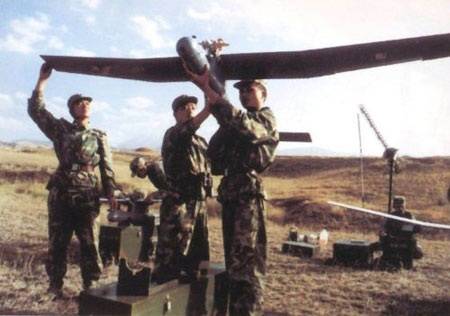
Aircraft weighing about 7 kg was created on the basis of the ASN-1 UAV, which was not accepted for service, the main drawback of which was insufficiently advanced control equipment and low quality of the transmitted television picture. In contrast, the ASN-15 is equipped with a new-generation miniature camera and a sufficiently powerful television signal transmitter. The ASN-15 UAV is capable of being in the air for about an hour, at a distance of up to 10 km from the ground control station. A miniature two-stroke gasoline engine provides maximum speed up to 80 km / h. Ceiling - 3 km. Wingspan - 2,5 m. Length -1,7 m. Due to the location of the engine and propeller on the upper part of the wing, the landing is made on the fuselage.
A further development of the lightweight ASN-15 UAV was ASN-217. This device is equipped with more advanced monitoring equipment, and the propeller rotates an electric motor powered by a battery.
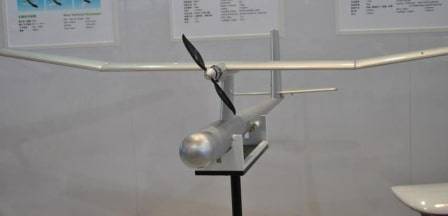
Take-off weight - 5,5 kg. In horizontal flight, the ASN-217 can accelerate to 110 km / h, cruising speed - 45-60 km / h. Duration in air - up to 1,5 hours. Distance from ground station - 20 km. The device was demonstrated in 2010 in Zhuhai, but its current status is not known. A number of experts believe that a single-use drone carrying an explosive charge and designed to attack ground targets can be created on its basis.
JWS01 and ASN-301 ammunition
In 1995, the PLA acquired Israeli “kamikaze drones” from the IAI Harpy family. The first models of "killer drones" of this family were created at the end of the 1980's, and several new modifications appeared in the future. This was one of the first projects of “barrage of ammunition”, implemented in practice. Israel Aerospace Industries has succeeded in creating a compact and relatively inexpensive drone capable of reconnaissance and striking air defense systems. Subsequently, the "Harpy" was produced exclusively in the shock version, and the surveillance tasks were assigned to other unmanned aerial vehicles.
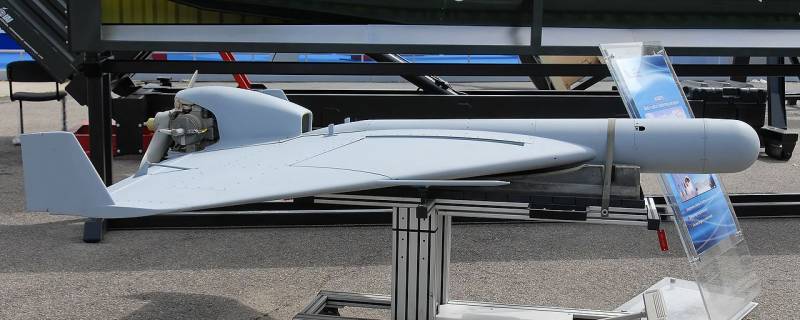
Harpy UAV is designed according to the “flying wing” scheme with a cylindrical fuselage protruding forward. An 37 horsepower internal combustion engine is placed in the rear of the apparatus. with a pushing screw. "Harpy" carries a high-explosive fragmentation warhead weighing 32 kg and is equipped with an autopilot and a passive homing radar. The length of the aircraft is 2,7 m, the wingspan is 2,1 m. Take-off weight is 125 kg. Speed - up to 185 km / h, with a flight range of 500 km.
Launch is carried out from a container launcher using a powder charge, return and reuse is not provided. After the start, the Harpy, under the control of the autopilot, entered the patrol area. At a given point, a passive radar seeker was included in the work, and the search for enemy ground radars began. When the desired signal is detected, the drone is automatically aimed at the source and strikes it with an explosion of the warhead. Unlike anti-radar missiles, the Harpy can remain in the desired area for several hours and wait for the signal to appear. At the same time, due to the relatively low EPR, the detection of a drone by radar means is difficult.
In the 2004 year, China expressed its intention to conclude another contract for the supply of a new batch of advanced Hapry-2 killer drones and the modernization of drones already sold. However, the United States opposed this, and an international scandal erupted. As a result, the PRC was refused the sale of new ammunition and modernization delivered earlier. However, by that time, Chinese industry had reached the point where it became possible to create such products on their own.
The Chinese version of "Harpy" was designated JWS01. It is generally similar to the product of the Israeli company IAI, but has a number of differences. For the Chinese ammunition intended for destroying air defense systems, there are two types of interchangeable seekers operating in different frequency ranges, which significantly expands the range of potential targets. The JWS01 UAV after launch is completely autonomous, and performs flight in accordance with a pre-programmed program.
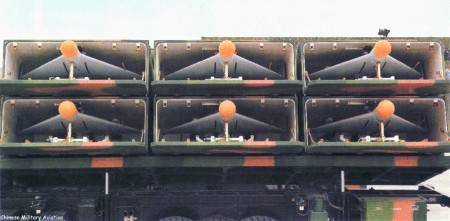
A mobile launcher on a Beiben North Benz all-terrain truck chassis carries six JWS01. The unit includes three self-propelled launchers, a radio intelligence station and a mobile command post. At the exhibition of arms and military equipment IDEX 2017, which was held in February 2017 in Abu Dhabi, an advanced model ASN-301 was presented. Additional antennas are installed in the lower and upper parts of the fuselage of the modernized drone-kamikaze, which, according to experts, allows you to remotely adjust the actions of the drone.
Thus, it can be stated that in the 1980-1990-ies in the PRC a reserve was created, which made it possible to fully equip the People's Liberation Army of China with unmanned aerial vehicles of light and middle class. Moreover, Chinese UAV manufacturers are actively crowding the international market with Israeli and American firms that previously held a dominant position in this segment.
To be continued ...
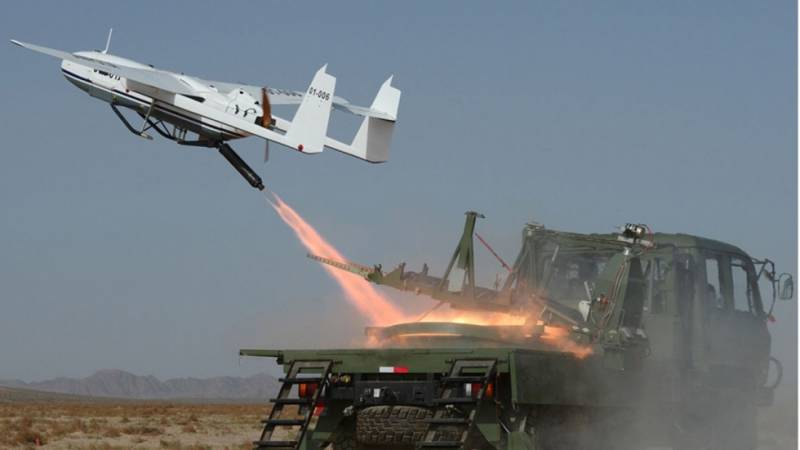
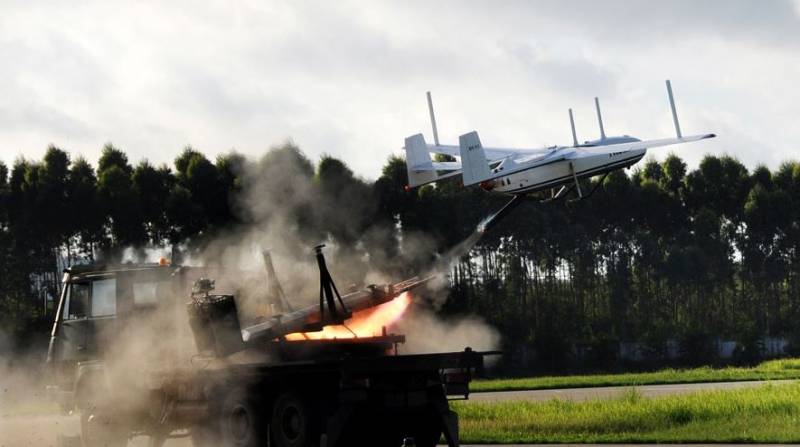
Information